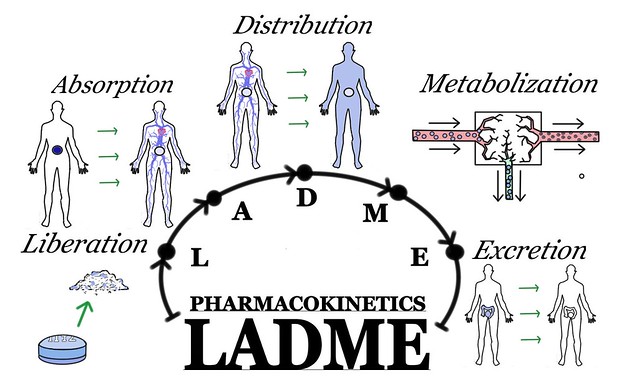Pharmacokinetics is a branch of Pharmacology that studies how a drug interacts with the body, from drug administration until elimination from the body.
This can be defined as somewhat of a life cycle for a specific drug. Every drug has unique characteristics of interaction with the body. Every drug has many interactions with different parts of the body as it completes this cycle. The “ADME" four step (or LADME five step) process of Pharmacokinetics is simple way to outline the major aspects of the drug’s activity from dose administration to dose elimination.
A bsorption - Process that leads to Drug entering the blood circulation
D istribution - Dispersion of Drug throughout body fluids and body tissue
M etabolization - Recognition by organism of foreign substance (drug) present in system, followed
by permanent transformation of parent compounds into daughter metabolites
E xcretion - Removal of Drug (including daughter metabolites) from the body
A similar model to ADME is the LADME model of the pharmacokinetic process. This is essentially the same, with the addition of an extra step at the beginning. “Liberation” can be added in before Absorption of the drug. Liberation refers to any specific way the drug is released from it’s pharmaceutical formulation (Example: capsule formulation vs tablet formulation, or an immediate release formulation vs extended release formulation).

Terms to Understand - Defined
Some words used in Pharmacokinetics (including the name itself) can seem intimidating for those just learning, but the concepts are fairly easy to understand. It is important to understand commonly used words throughout this subject. In fact, learning these terms will be useful in understanding prescribed medication and much more. Deeper and more complex discussions allow you visit your physician or pick up a prescription from your pharmacist
Peak Plasma - When drug level in plasma reaches it's peak concentration. Peak Plasma Concentration is represented by the actual peak concentration achieved (example: 2mg/L) as well as the time required from administration to achieving the peak level
Half-Life - The time required for half of dose administered to be eliminated (excreted) from the body
Bioavailability - Percentage of dose administered that reaches systemic circulation (the bloodstream), often IV administration of drugs is 100%

Comments
Post a Comment